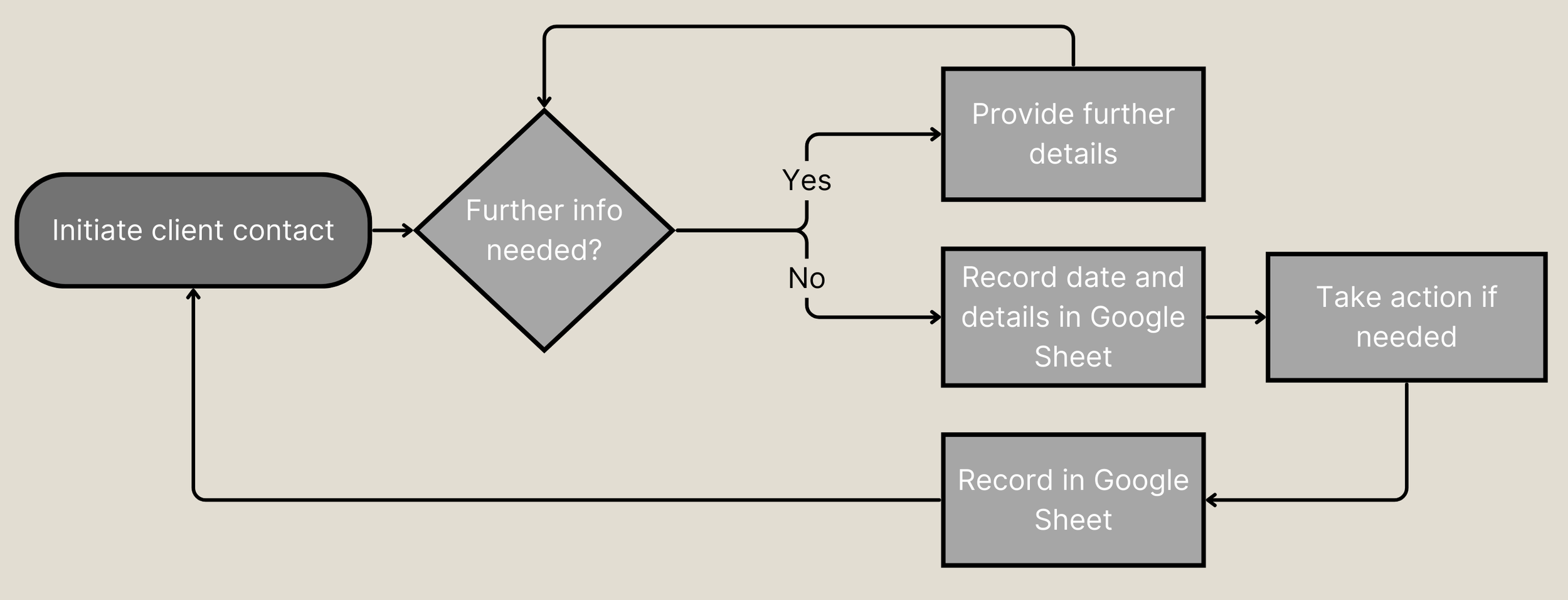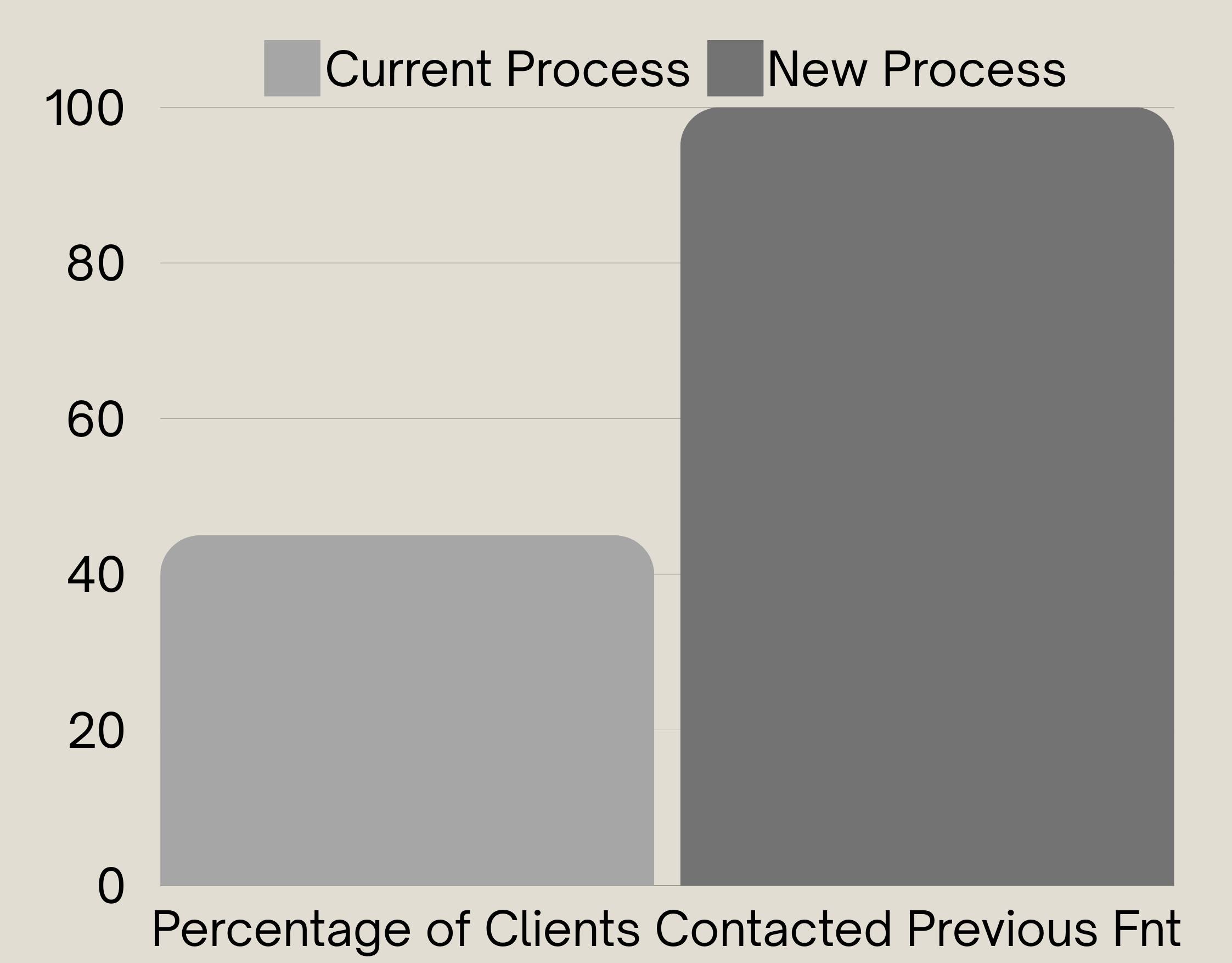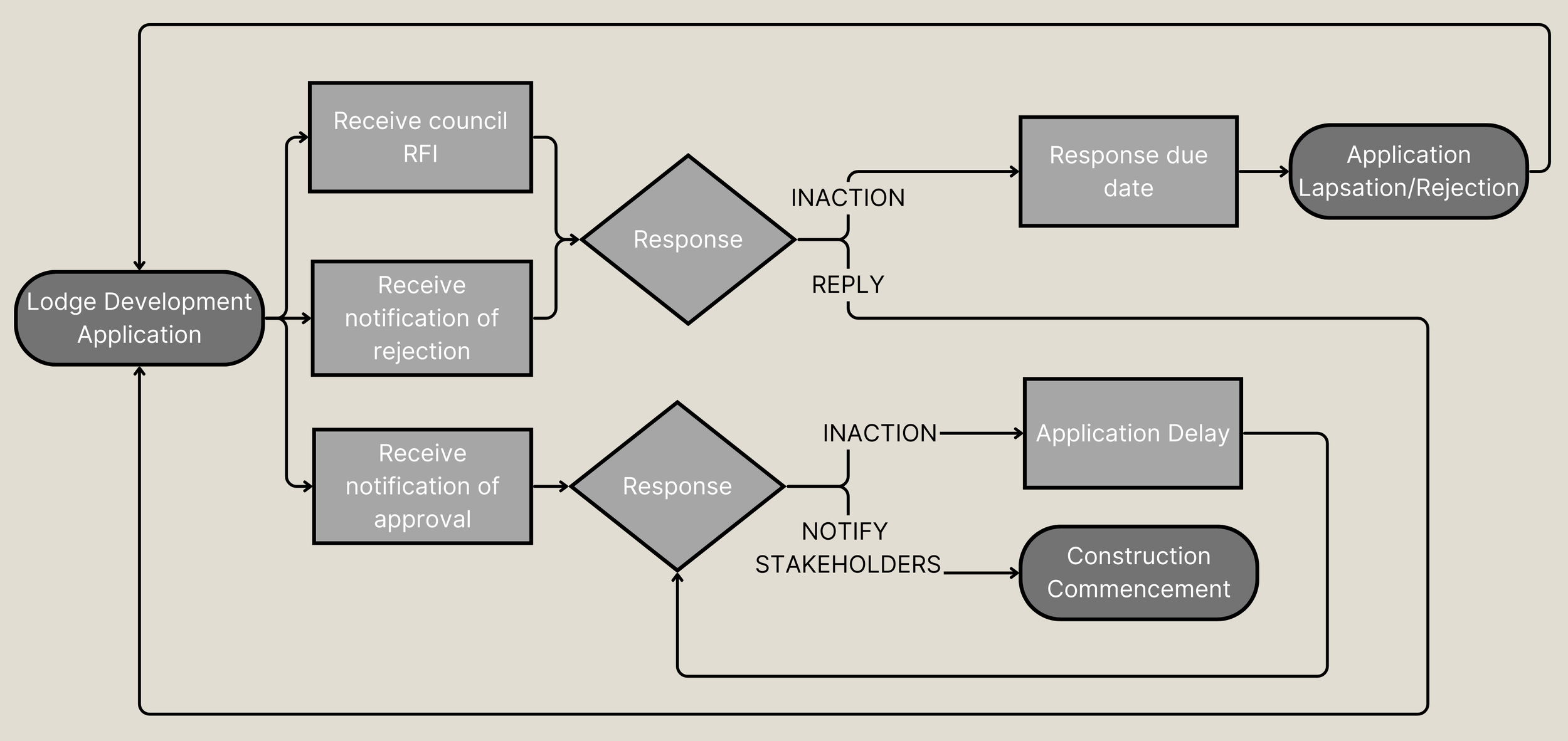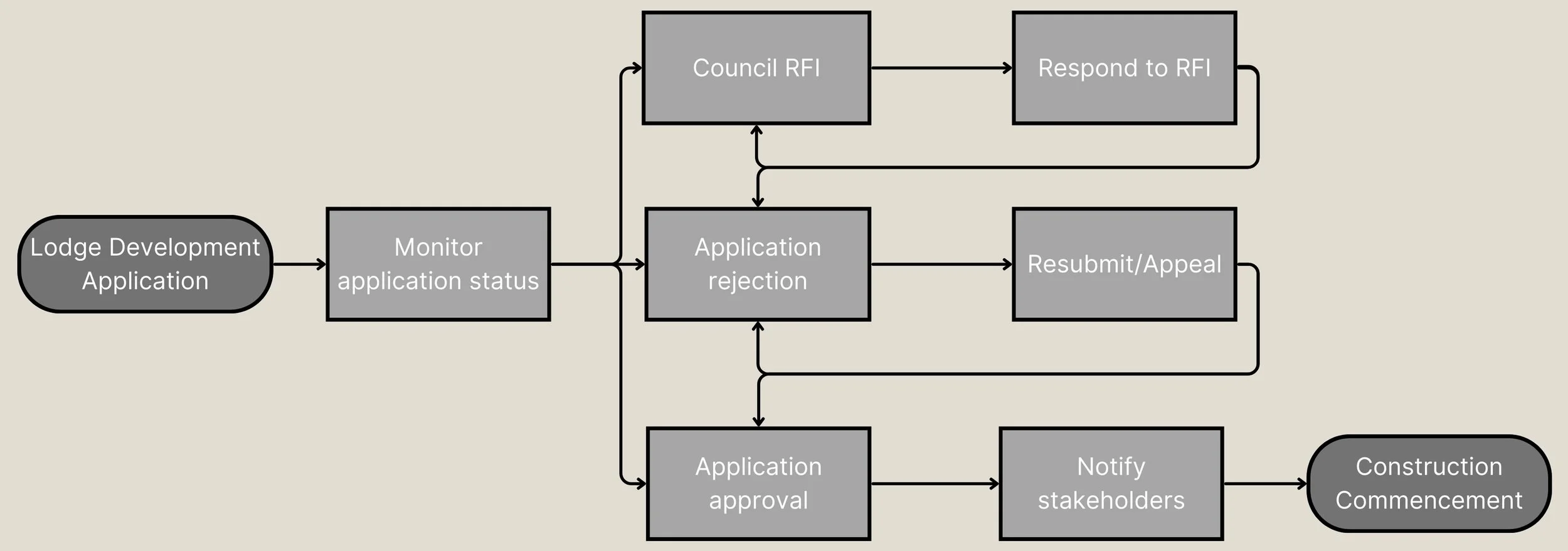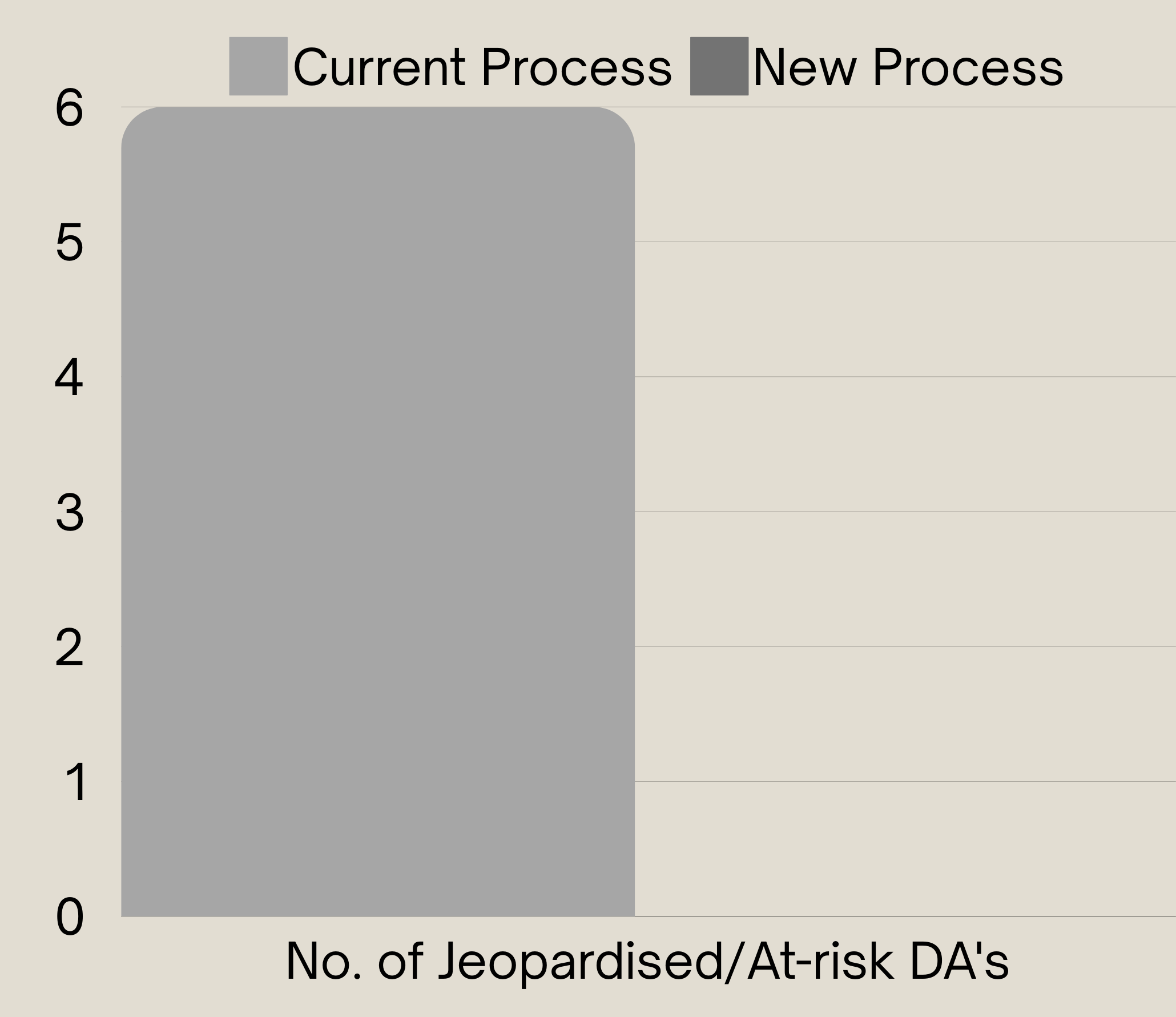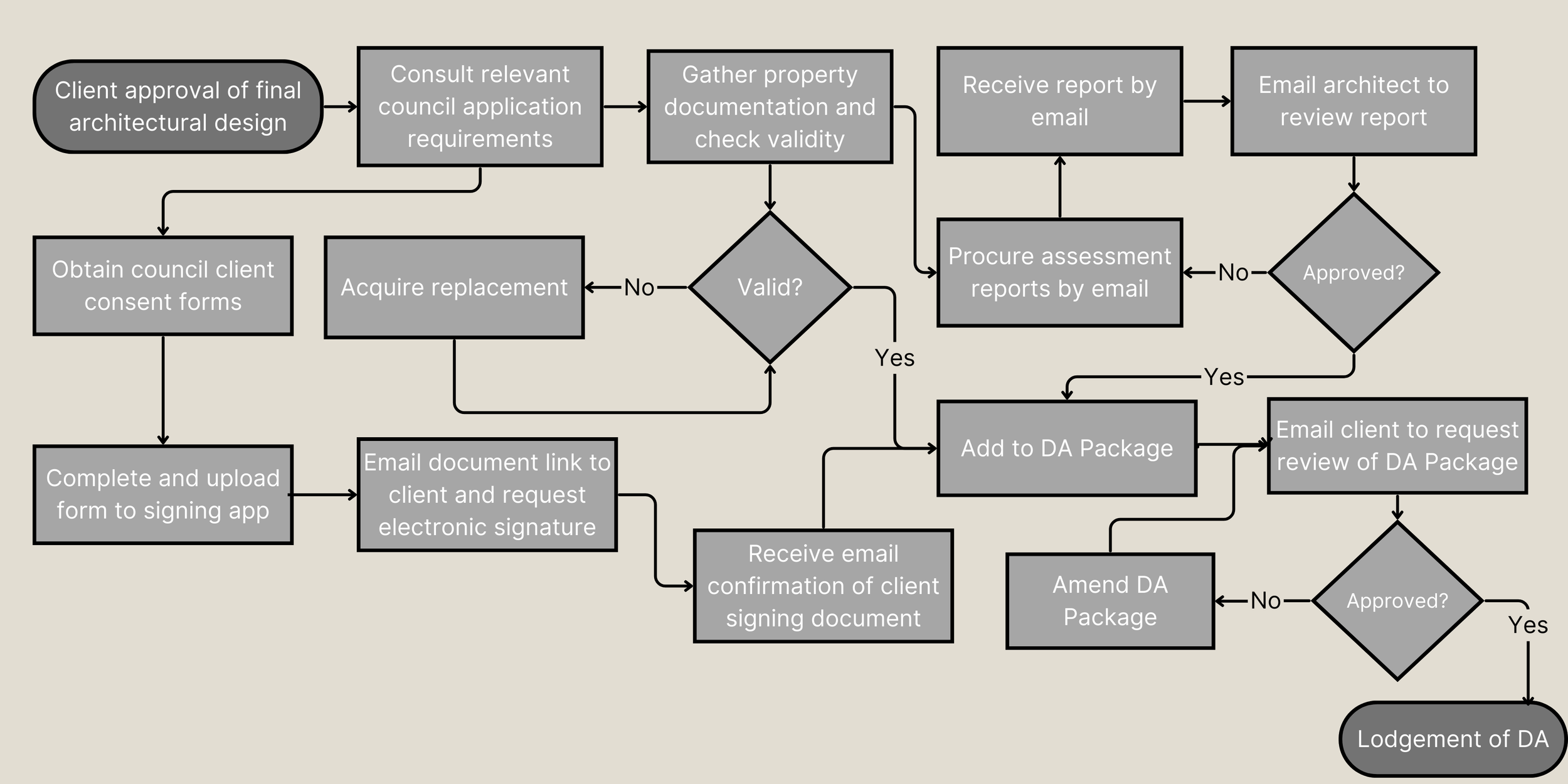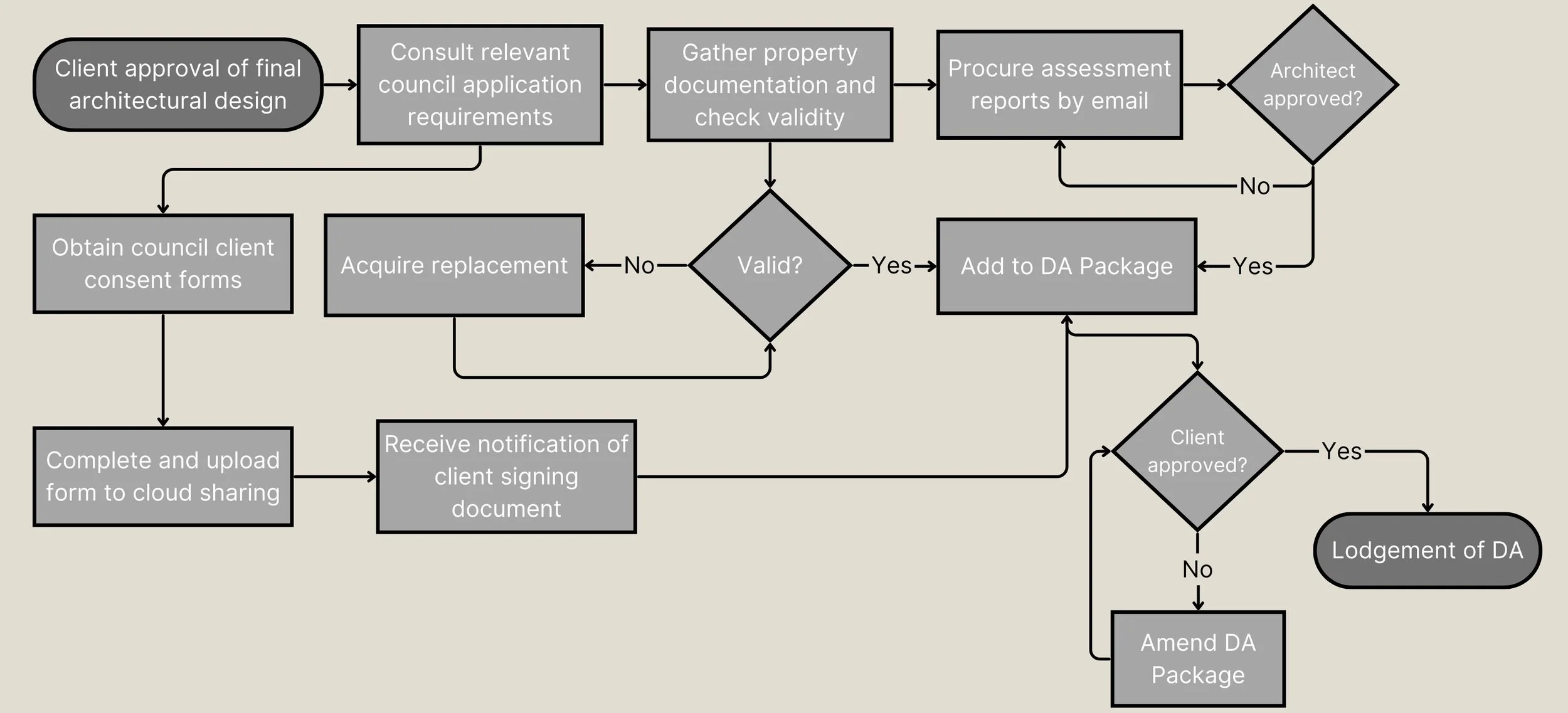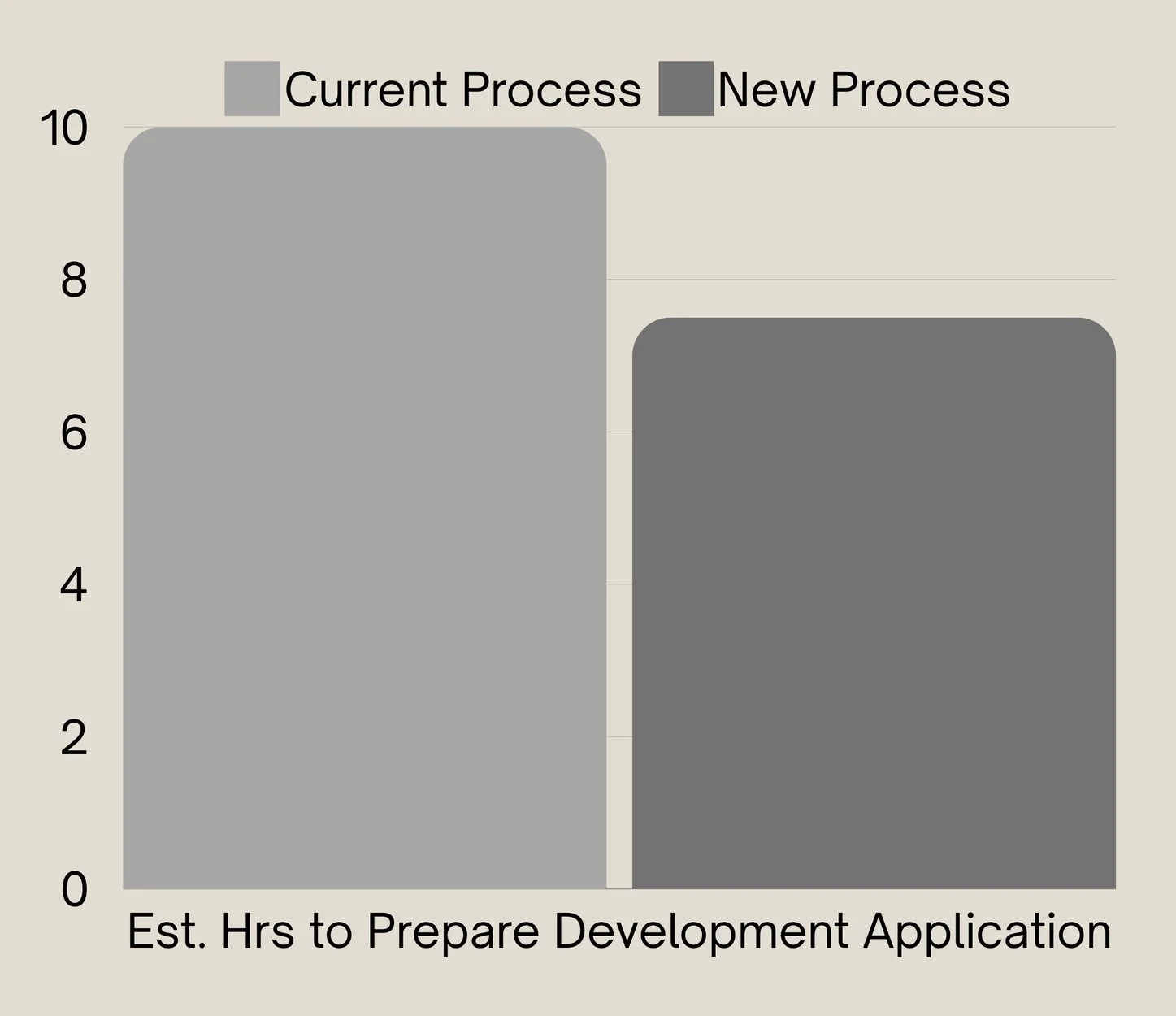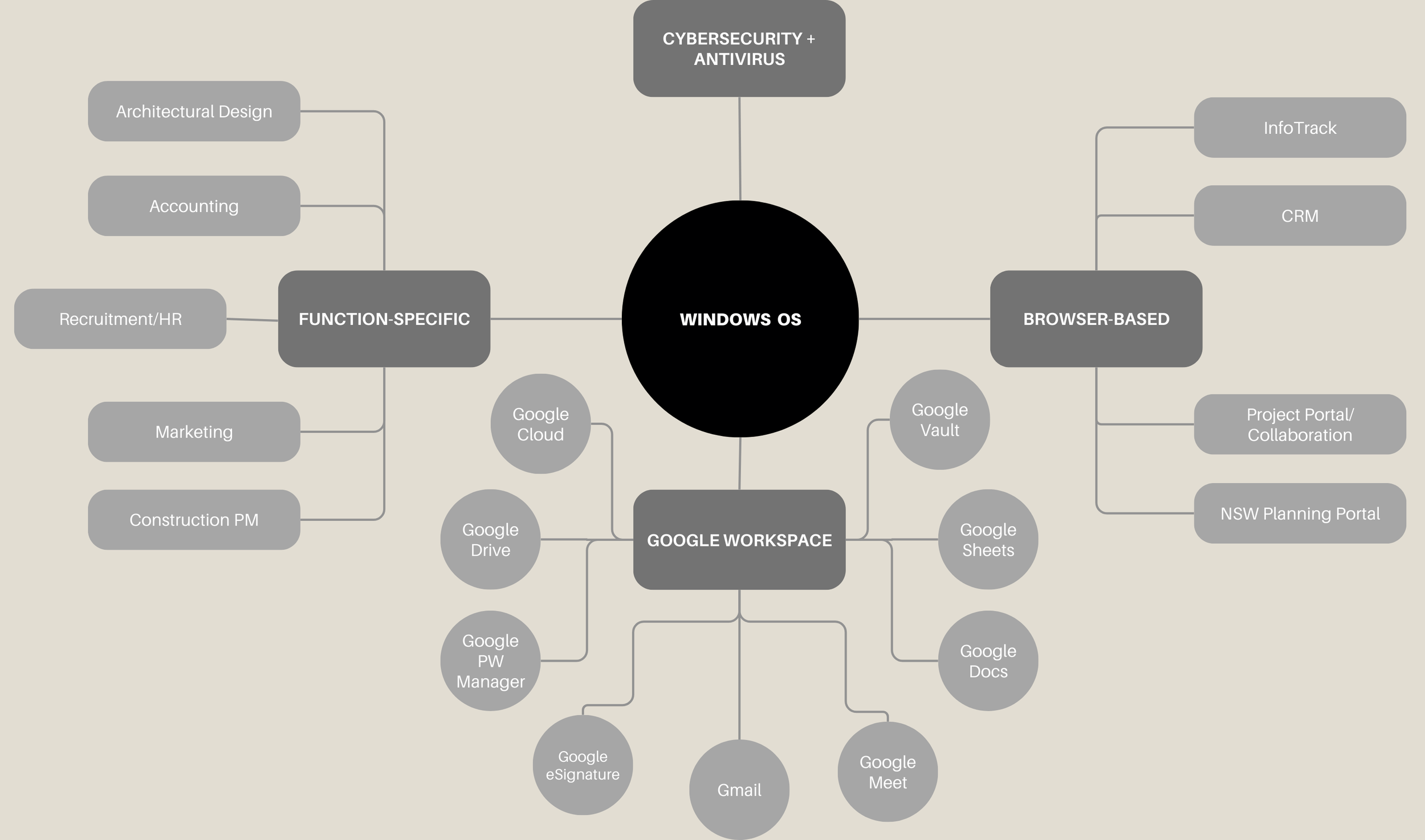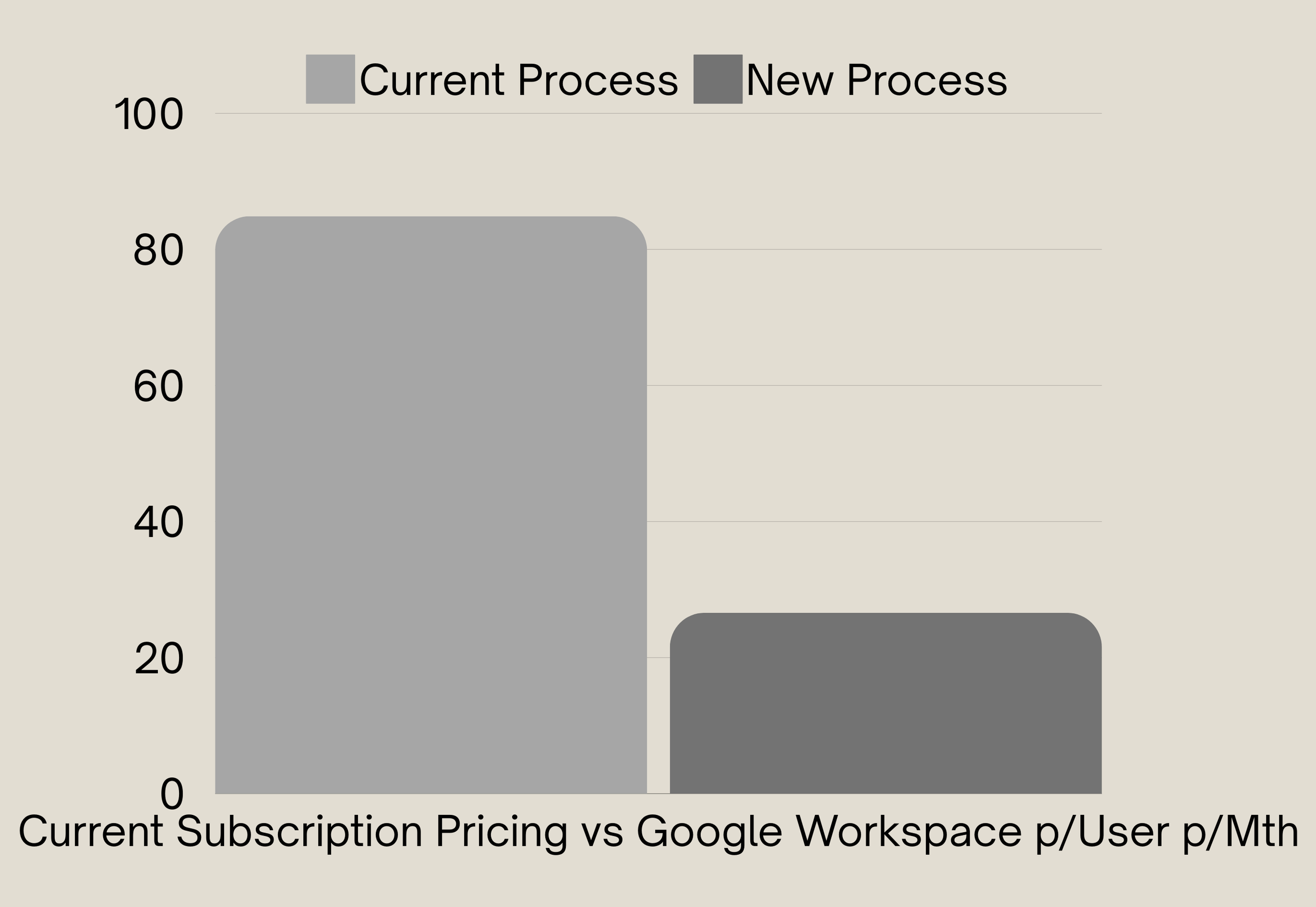
Overview
Organisation: Architectural design practice
Structure: Small business
Lifecycle stage: Decline
Goal: Renewal
Solution: System transformation
Technology: Google Workspace
Project duration: 3 months
This case study consolidates five smaller projects undertaken at more than one business, in the scenario of an architectural practice seeking to renew its strategy and services after the difficulties of the pandemic. Through observation, desktop audits, walkthroughs, consulting staff, and interaction with clients and contractors, a digitalisation plan was created and five quick wins identified and designed for early implementation to show the benefits of transformation and build momentum for change: Client communications scheduling towards introducing a CRM, document management as a foundation for cloud migration, development application monitoring system and dashboard, a project portal prototype towards enabling online document management, sharing, and collaboration with contractors and clients in the development application process, and system redesign for simplification and streamlining of team service delivery and collaboration processes.
Analysis
3 in 5 SMEs reported experiencing ‘bad digitisation’
Source: MYOB, 2023.
Strategy
“Businesses lose one full day each week carrying out tasks caused by a lack of software integration” - MYOB, 1 September 2023.
Many small businesses were slowly navigating the process of digitalisation when the pandemic hit in 2020. The OECD (2021) reported that the gaps in digital adoption had increased for small businesses with 10-49 employees over the preceding decade, and although an estimated 70% of SMEs worldwide accelerated digitalisation during the pandemic, many were ill-prepared for such radical transformation (OECD, 2021). By June 2022, 59% of surveyed Australian SMEs reported experiencing ‘bad digitisation’ (MYOB, 2022), where the software applications of a business are run in silos rather than seamless integration, costing time, money, and resources, and increasing strategic risk. Now, with AI propelling digital technology ahead at light speed, those who have not yet resolved this are at risk of falling even further behind.
Best Practice: What is ‘good digitalisation’?
MYOB (2023) suggest that the key to small business overcoming ‘bad digitisation’ is to either find one solution that does everything the business needs or find systems that integrate well with each other, and - with the inherent security risks entailed in placing all business functions into the hands of one software vendor - the Goldilocks approach is likely to be somewhere in between. Increased interoperability and integration pays off for both the vendor and the user in most instances, so even since the publication of the MYOB (2022) report, major players have been making strides towards this end, with many affordable options available, such as Google Workspace.
Recommendations
The size of the business, its current circumstances, and goals, as well as its increasing use of the Google suite of products meant that fully committing to this ecosystem would likely bring more benefits that costs or risks, including relinquishing subscriptions no longer needed for separate services. Secondly, digitalising two outsourced functions and one desktop function would increase their visibility and integration into the main business, while trimming down bulky infrastructure and streamlining processes. Thirdly, modernising the development application preparation, management, and construction process by digitalising collaboration.
Digitalisation Plan
Google Workspace
The key benefits for the business of opting in to Google Workspace are that it integrates the main business activities into one application, including communication and collaboration across email, chat, and video, digital marketing management and analytics including YouTube, document management and sharing, secure file storage, search and syncing with Chrome, as well as other applications the business does not use yet but may consider in future, like Travel, and third-party integrations across business function-specific applications such as recruitment, customer relationship management, and cybersecurity. Finally, Google offers Gemini in Google Workspace for an additional monthly fee per user. Gemini can further integrate, enhance, and analyse data across the different Google Workspace applications to generate business insights, documents, communications, summarise meetings, and more.
The business could first optimise its use of Google Workspace for service coordination, before including the design team, project management, marketing, accounting, recruitment, and IT. Regardless of its preferred implementation approach, security should be among the first considerations for its deployment, including user management with strong passwords in a password manager. In terms of use cases across different business functions and assisting staff to learn how to use its full capabilities, Google provides an abundance of resources towards this end, including Cheatsheets for each of its apps, role-based guides for areas like customer service, sales, marketing, human resources, IT, project management, and professional services, and to assess the business case for Gemini, the Gemini for Google Workspace Handbook covers how it works, use cases, and impact on revenue and costs.
Third-Party Integrations
Google Workspace Marketplace offers a number of CRM, HR, and project management or task management applications, which could be a factor for consideration when choosing a commercial application in these business functions.
Benefits of installing apps from the Marketplace into a Google Workspace environment include enhanced productivity through streamlining workflows; managing the apps through the Admin Console; collaboration efficiency through real-time communication, task tracking, and document sharing; customised workflows to suit business needs; and the apps are generally vetted by Google to meet high security and privacy standards. Overall, integrations make it easier to align different tools into one cohesive system, reducing friction and improving team productivity.
Productivity
Google Workspace for business includes instant communication and collaboration through video meetings, email, and chat using Google Calendar, Gmail, Google Meet, and Google Chat; instant file location and secure storage using Google Drive; and creating, sharing, and presenting professional templates, project plans, and slide decks with Google Docs, Sheets, and Slides.
The core Google apps such as Gmail, Calendar, Drive, Docs, Sheets, Slides, and Videos, are included, as well as the Google marketing apps used by the business such as AdSense, Maps, Business Profile, Analytics, Google Marketing Platform, and YouTube. It is in the area of productivity that the current Gemini model can make the most significant contribution, which the business may consider for key staff to trial.
Project Collaboration
The business has three main options for digitalising project collaboration across the service team, design team, project team, clients, and contractors: using applications built into the Google Workspace environment - including the option of Google Sites, subscribing to a commercial task management application, or using a Google Sheet to create a project portal with authentication.
A possible strategy is to start with the least costly option, which would be to first set up this function within Google Workspace. Google Workspace cites a number of benefits for project management, including streamlined team communications, managing schedules and tasks, and sharing files and collaborating on content, and may well be adequate for the present needs of the business.
Quick Wins
Module 1: Client Communications
Challenge
A short period of interaction with clients revealed dissatisfaction with communication from the business, including not receiving responses to enquiries, not receiving updates on development application or project progress, and inconsistent responses from staff to queries. Several client complaints had been received and a small number had cancelled their contract and/or left poor public reviews for the business.
Aware of a verbal management request for fortnightly updating of clients at a minimum, an audit was undertaken of client phone call notes, emails, and formal client documentation such as contracts and design meeting notes. This revealed a group of clients who had not received any contact from the business in three to six months, a larger group who had not been contacted for one to three months, and a passive approach to client relationship management.
Solution
A set of Google Sheets accessed by the service coordination team on a daily basis was modified to provide a client contact scheduling function. A column was added to each Google Sheet recording the last contact date with the client, and colour-based conditional formatting added so that as the period since last contact approached 14 days, the service coordination team would be alerted and could take appropriate action, updating the Google Sheet when contact had been completed. This function could be better performed by a professional application such as a CRM, or a group email account for the business where reminders and calendar events are created to manage client communications. More ideally, a project portal could be implemented, as discussed below, for the client to access updates on-demand.
Results
Through maintaining the client contact column in the client coordination spreadsheets a quick and easy system of tracking client communications was established on a document accessed daily by relevant staff to ensure client project updates were issued within the timeframe set by management, and client satisfaction was maintained throughout the duration of their project.
Module 2: Document Management
Challenge
The business held weekly meetings with each member of the architectural design team to discuss progress towards their projects by the designer, service coordination team, and project team, barriers to further progress, and any additional support needed by the designer to get their work completed on time. The service coordination team would prepare this meeting by updating the relevant project register, printing copies of it for the team, and then making notes on the register as appropriate during the meeting. This project documentation was being maintained on both Windows and Google, entailing duplication of records and processes, making the preparation of each meeting an unnecessarily time-consuming process.
Solution
Service coordination team members were consulted and discussions held with senior staff to highlight the effect of using both systems on productivity and efficiency, and the benefits to the business of opting for one system or the other in regards to project documentation, as well as the value of undertaking intentional planning in relation to the overall information system at a later time, including possible cloud migration and either fully opting in to one productivity ecosystem or integrating use of Microsoft and Google across different functions.
Results
By eliminating duplication of documentation across five weekly design team meetings, the service coordination team saved an estimated 27 minutes per meeting, or 2.25 hours per week. This time was able to be spent ensuring other service coordination tasks were up-to-date before each meeting commenced, and to get ahead on tasks otherwise undertaken and completed later that day. Qualitatively, it also reduced the workload stress experienced by service coordination team members and improved their ability to record and participate in the design meeting.
Module 3: Development Application Management
Challenge
While the business actively maintained this project register in Excel and Google, and then just Google, to manage the architectural design and development application preparation process, once the application was lodged with the government planning portal, the business relied on the staff member who lodged the application to monitor their emails for application updates or requests for information (RFIs) and then convey any important details to the rest of the team and the client. This process was very susceptible to error for a number of reasons, with risk of application rejections or RFIs going unnoticed, leading to the application needing to be resubmitted. When one such occasion occurred, an audit was undertaken of applications lodged to the government planning portal over the past year, identifying further applications that had received adverse outcomes or needed to be resubmitted.
Solution
The application data from the government planning portal was transferred to a new Google Sheet for the business, with colour-coded conditional formatting on columns of important information, such as date of submission, to indicate applications that needed closer attention and possible action. Additionally, a dashboard was created to show performance of development application lodgements over the previous year, to highlight areas for improvement in preparation that could prevent application delays or rejections in future. Lastly, a method of checking the government planning portal at least once each day was established to ensure that the business maintained adequate oversight over application progress. In future it could even use this data to find indicators of different application outcomes and take pre-emptive action to give applications the best probability of approval.
Results
Instituting a digital method for monitoring progress of development applications each day by the business ensured that service coordination staff had full, accurate, and up-to-date information about each application in progress, and was able to take responsibility for any action that needed to be taken as requested by the relevant council. It therefore provided assurance that all applications had the best possible chance of being approved.
Module 4: Project Portal
Challenge
The process of preparing a development application for clients involved a lot of back-and-forth by email between the business and the client, and the business and contractors hired to conduct assessments and inspections. This caused inconvenience for all involved, took a great deal of time, and often created delay in finalising the application for lodgement.
Solution
With today’s cloud storage, document sharing, and collaboration software, there are a bevy of affordable options that the business could choose from. A solution that can be built from existing spreadsheet software used by the business is a portal for clients and contractors, using a low- or no-code application such as Softr or Noloco. A prototype portal was designed based on the Google Sheets used for monitoring project activity and the existing process for preparing development applications. The diagram illustrates the potential effect of using cloud sharing and automatic notifications for service coordination instead of emailing repeatedly between contractors, the architect, and the client.
Potential Benefits
With a typical development application taking approximately 10 hours of direct work by service coordination staff over the course of its preparation to point of lodgement, modernising the development application preparation process has the potential to save up to an estimated 2.5 hours per application. With around 20 applications prepared each year, this could save 50 hours annually, or 1.32 weeks’ work. Digitalising project collaboration from the application preparation stage provides a pathway for this method of collaboration to continue through the construction stage of the overall project, enabling the project management team greater involvement in and awareness of the client’s journey from the very start. This also creates a better working environment for the three separate teams in the business - service coordination, architectural design, and project management - many of whom work remotely and would otherwise not have the opportunity communicate.
Module 5: System Modernisation
Challenge
Due to the pandemic, the business had not considered digitalisation of its systems sooner and consequently its services had not realised the benefit that such software can bring to client communications and relations, staff recruitment and retention, and information security, and overall business operations.
The existing system structure as mapped out at a high level here provided global access for all users to Microsoft applications, service coordination team access to browser-based applications, and access for the design, accounting, marketing, and project management teams to their own Google Sheets and function-specific programs.
System-related issues resulted from the design team’s lack of access to the Google Sheet project registers, lack of a group/business account for Google, disorganised storage of client records, and service-critical applications like Docusign, Dropbox, and Zoom using individual rather than group-based access.
Solution
Based on discussions with senior staff and team members, listening to team discussion, observation, and experience in different service processes, vendor research was undertaken into simplifying the system to enable more streamlined processes, through unifying operations into one productivity ecosystem and identifying three business functions to consider for digitalisation with a COTS, with three possible vendors for each software type selected and seven criteria used to evaluate each vendor.
Potential Benefits
Where current subscription pricing includes monthly per user cost of Dropbox Plus, Docusign Personal, and Zoom Pro, and Google Workspace refers to Business Plus.
By setting up a business subscription to Google Workspace, the business could save the cost of individual team member subscriptions to Zoom, Docusign, and Dropbox, and save money from no longer needing an on-site server or outsourced IT support, as well as prevent delays or rework caused by staff leaving or going on leave without providing access to their account, enabling full visibility of project status and issues at all stages, and centralising data storage for easy, on-demand access as needed.
By digitalising its staff recruitment, client relations, and information security processes, the business could firstly attain full control over applicant tracking to enable monitoring, analysis, and improvement of staffing processes; secondly, the business could boost its service delivery considerably, with client data, communications, and records standardised for easy analysis, trouble-shooting, and insight generation; and thirdly, it can manage the risk of data breach or financial theft.
Lastly, by creating a project portal for clients, contractors, and the business team, or subscribing to a simple, affordable application, enabling this function, the business could add untold value to the services it brings to its clients, eliminating the risk of communication issues such as those originally identified, improving its reputation, and increasing organic growth sustainably. Hence digitalisation could both save money for and increase profitability of the business.
Summary & References
This case study provides an overview of how process, service, and system analysis can be used to identify opportunities to create value and improve client relations, service delivery, and overall project performance in a small architectural practice:
Introducing a client communications schedule increased achievement of a core KPI and significantly reduced client complaints and dissatisfaction
Eliminating task duplication saved several hours of work per week
Process mapping, modelling, and analysis of development application preparation identified potential time savings of over one week’s work per year through digitalisation.
A procedure for monitoring development applications eliminated risk of lapses and unnoticed rejections
System mapping and analysis found that hundreds of dollars could be saved each year, at the least, through reviewing and refining the system design.
While benefits such as time, money, and approvals are typically easily measured, the goodwill that is generated through the valuing and respecting of people involved in a business - clients, contractors, staff, and stakeholders - is more easily assessed through its indirect impact. Putting people first in any business transformation always yields best results and initiatives such as the above can accelerate such efforts.
An important part of the people-first approach is to be data-driven, and effective data governance needs a well-structured information system. Managing and monitoring data from business operations can identify problems before they impact people, and find opportunities to proactively improve processes, services, and systems, to delight, support, and empower them instead. Data visibility, governance, and analysis enables a business to stay one step ahead of problems and opportunities, giving the business the best chance of sustaining success.
REFERENCES
Google (2024). Gemini for Google Workspace Handbook.
Google Workspace – Small Business Productivity. Simplify how you work.
MYOB (2023). Digitised but disconnected: 3 in 5 SMEs report digital solutions are hindering, not helping.
MYOB (2022). The Digital Disconnection Challenge (PDF). MYOB Report, June 2022.
OECD (2021). The Digital Transformation of SMEs. OECD Studies on SMEs and Entrepreneurship, OECD Publishing, Paris.
Pappu, A. (2024). GM and Vice President, Google Workspace. New ways to engage with Gemini for Workspace, 15 May 2024.


